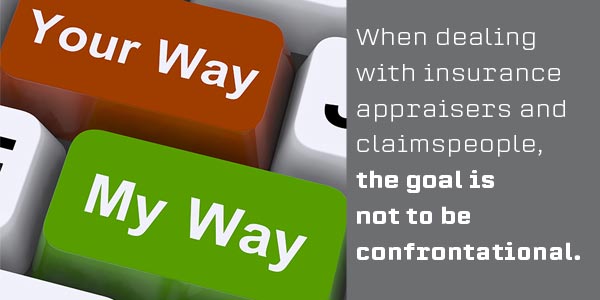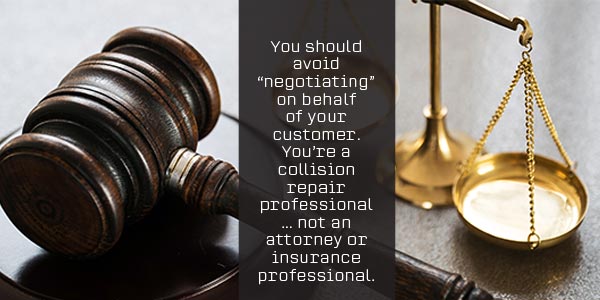As I’ve stated before, this is no longer your father’s auto body repair industry.
The following is an excerpt from my company’s internal policies and procedural pages that illustrates why a collision repair facility having such documents will allow it to operate more efficiently and consistently. These documents are important for day-to-day operations as well as preparing for growth and opening more shops.
No More Estimates
Estimates are no more; damage/repair assessment a.k.a. repair planning is here.
To prepare a comprehensive repair plan, one first must fully assess and identify the damages to be repaired. For this reason, what was once referred to as preparing an assessment should now be considered a damage/repair assessment. Of course, all repair plans should be consistent with the original equipment manufacturers’ (OEM) recommendations, requirements and mandates. Note that some restrictions may apply.
Avoiding Conflict
I want to be sure that everyone understands the basic principles and goals for enchancing your company’s policies and procedures and to help you develop word tracks to employ when confronted with various situations — especially in potential confrontations with consumers and/or insurance claim representatives that may occur in day-to-day activities and operations. Our goal is to avoid conflict and develop healthy and beneficial relationships with claims people but to do so on a foundation of professionalism and mutual respect. Note: This is also true in building healthy and positive relationships between your team members and all others, including those “internal customers” within your company as well as outside parties, such as suppliers, vendors, delivery persons, tow truck drivers, etc. Remember … everyone you meet at work or play is a potential customer!
This level of mutual respect with claims people can only be achieved through extending professionalism, courtesy and a sincere interest and caring for the needs of those we serve. For the collision repair industry, it’s the vehicle owner and their family.
When dealing with insurance appraisers and claims people, the goal is not to be confrontational. When confronted with unprofessional conduct from others, we need to handle the situation with poise, patience and professionalism. This can be difficult at times, but the true professional will try to diffuse the situation or excuse and distance themselves from the event. This is highly recommended when the other person is being less than professional and merely trying to intimidate you or take their “pound of flesh.” This will simply be a sign of the other person’s lack of professionalism and their consternation and frustration in not having the control they believe they once possessed over you.
The Claimsperson
Let’s focus on insurance claims representatives (i.e., claimsperson, appraiser, etc.).
A claimsperson may be an independent appraiser hired by the insurer or a staff member who is an employee of the insurer. Either way, their responsibilities and obligation will be to the insurer and whatever legal and contractual obligations they may have to the vehicle owner (third-party claimant or named insured or policyholder). In some instances, the repairer may have the authority to write an assessment of repair on behalf of the insurer.
In the past, an adjuster/appraiser performed three basic functions on behalf of the insurer:
- Verify the vehicle damage, or damages caused to others, was caused by the insured vehicle as listed in the policy.
- Verify that the damages claimed are the result of the covered loss (not claiming old damage part of recent loss).
- To provide the carrier an assessment for the potential exposure as to set funds aside in “reserve” as called for by state and federal overseers.
Only due to the acquiescence of repairers has the appraiser/adjuster’s duties included writing repair assessments and/or undertaking negotiations with repairers regarding repair methodologies, parts sources and materials.
Most issues that arise between repairers and claimspeople relate to the repair assessment. Insurers often write too low, while some repairers are viewed as writing too high. The likelihood is a repairer will never write an assessment lower than a claimsperson, and a claimsperson will rarely write one higher than a repairer’s … unless a significant error or oversight occurs.
Writing the Assessment
The repairer should write an assessment on every vehicle (even if by merely entering the insurer’s assessment into the repairer’s estimating system) and then capture it and generate a supplement — and, whenever possible, base it on what is found after dismantling the damaged vehicle. This saves time and reduces the potential for supplements and last-minute part orders and completion delays. Supplements cause added costs in administrative activities and additional loss-of-use or rental costs, and they also lessen customer satisfaction.
Pre-assessment dismantling (a.k.a. teardown) is an important part of the concept of lean processing and avoiding unnecessary delays in obtaining unforeseen needed parts and labor. The goal should be to write a thorough and accurate damage/repair assessment to enable the ordering and acquisition of all necessary parts and materials prior to initiating the repair and avoid tying up a production stall and waiting for supplemental parts. This process is especially crucial in shops that have a shortage of space and high volume.
Should the vehicle owner request that a repairer stop repairs to await an insurer’s claim activities (i.e., reinspection, investigation, approval, etc.), the repairer may consider taking the vehicle out of production and place it in protective storage until such interruptions have been resolved and the customer requests that repairs begin again.
Time is Money
In the collision repair industry, “time is money” — and repairers invest a significant amount of money in parts, labor and materials (and acceptance of potential liabilities). The return on investment only occurs when the repairs are completed and the customer provides payment and drives away.
You are a collision repair professional and, when preparing a damage/repair assessment or supplement, you should do it well. Whenever possible, make it bulletproof and backed by written repair procedures from the OEM, I-CAR or suppliers. This will avoid potential delays and customer inconvenience and earn the claimsperson’s respect.
Remember, by preparing a repair plan or supplement, you are, on behalf of your customer, offering your professional and expert opinion as to what is required to properly restore their damaged property to its pre-loss condition to the best of human ability in a timely manner. You’re also informing them of your company’s cost to render those services, parts and materials while incurring the real and significant liabilities associated with each.
The alternative to a proper and thorough damage/repair assessment that includes all necessary and recommended parts, procedures and materials and is based on OEM recommendations is preparing a “guesstimate” and doing it for free … at your company’s expense, incurring all the liabilities and expense that go along with it!
Write only what you need to do … and do what you receive ample compensation for. Nothing can be worse for your reputation and future relationship with claimspeople than being caught for not doing what you said you were going to do. The second worst thing is doing things for free!
Customer Review
Once the damage/repair assessment or supplement is completed, you should then submit it to the customer for their review. You should then ask your customer to come in and go over the assessment with you. It’s preferred to do this at their vehicle so they can better understand and see your recommendations firsthand.
I encourage repairers to ask the customer if they fully understand what is needed for a proper and thorough repair and if they agree that your recommendations will accomplish this. If they agree, ask that they write on the calculation page of your assessment, “I hereby agree to the repairs as written” and ask that they sign and date below it. Once this is done, you should ask the customer if they would like you to send the assessment to the insurer on their behalf. Note: Most shops have done this without asking and have never received the kudos for the added service. Doing this also involves the customer and puts them in charge of their repair.
Once requested, submit the assessment to the insurance claimsperson on your customer’s behalf. Oftentimes, the claimsperson will arrive unexpectedly at your facility and ask to see the vehicle and your documentation. You provide them a copy of your assessment/supplement, hand them the vehicle’s keys and have them either escorted or directed to the subject vehicle. You should then be free to return to your normal duties of assisting others.
Because your damage assessment is written thoroughly (and, if applicable, likely higher than that of the insurer’s original amount), the appraiser may have questions or may walk into your office with an attitude and begin telling you what they will or will not be paying for. Or, they may want to ask you questions about your assessment.
If you’ve written your assessment thoroughly, each line item needing explanation will have the description and footnotes needed to explain the process to a consumer. The information within the assessment should be easily understood by the appraiser as well.
Negotiation
Some appraisers may try to press you to discuss your assessment. In such instances, it may be an effort to intimidate you or provoke a confrontation. In these situations, you could state:
“You have our professional and expert opinion as to what will be required and deemed necessary to restore the vehicle to the best of human ability relative to function, appearance, safety and value, and the costs thereof. Any deviations from our expert recommendations should be discussed with the customer as it is their vehicle and their personal and economic well-being that is at issue. I stand ready to assist the customer in these regards; however, I am unable to ‘negotiate’ their claim. However, upon your review, should you find we have made an error, please let me know so I can review it and make the appropriate revisions. Have you found any such errors in our assessment?”
Should they reply, “No, but I want to go over it,” I would politely respond with something like:
“I understand, but unless you’ve found that we’ve made an error, there is nothing to go over. You have our professional and expert opinion, and I have other responsibilities I must attend to. If there is nothing else, have a great day.” And then politely go about your business, allowing them do the same. Caution: Unless otherwise mandated, you should avoid “negotiating” on behalf of your customer. You’re a collision repair professional … not an attorney or insurance professional. Therefore, under most state laws, you cannot legally negotiate or settle insurance claims on another’s behalf. Many states consider this the unlicensed practice of law, and myself and other shop owners have been accused of such behavior by insurers in the past. Note: In some states, repairers are required to negotiate with the insurers, and there are proven methods to do this correctly. Once again, it begins with knowing your state’s laws, rules and regulations.
Should they state that you made an error, find out what it is and deal with it appropriately. The old adage, “Never let them see you sweat!” applies: The goal is to never let them see that you’re angry, nervous, uncertain or upset. The best way to avoid this is to be confident in what you do, always know your position and be able to back up what you say and write when necessary. Explanations are reasonable; justifications are not.
Claimspeople will often ask you to explain a procedure you’ve listed. Being professionals, they should already know the what and why. Sometimes this is out of lack of experience and/or ignorance, and sometimes it’s merely their attempt to place you in a position to have to explain or justify your reasoning (as a means to punish you and take a pound of flesh). If they insist you justify something that you’ve recommended, ask that they put their questions in writing and then tell them you’ll be happy to respond accordingly.
Educating others is a worthy investment of your time and allows you to earn their trust and respect … but having to somehow justify a listed procedure and/or part or material is simply a waste of your time. Ain’t nobody got time for that!
Making Mistakes
We all make mistakes … and most claimspeople will be doing their best to find yours! Some will often use a simple mistake against you to discredit you and undermine your credibility with your customer. “To err is human,” yet you never want to be caught off guard, unprepared or in error. If you’re caught off guard, know how to react, recover and respond. Be courteous, concerned and committed in doing your job to the best of your ability. Tell them you’ll investigate the possible error and get back to them with your findings or, if it is an error, thank them for pointing it out and make the necessary corrections right there and then if possible … then get them to approve all the other items on your assessment.
As far as deviations from approved repair plans, avoid any instances where your company’s integrity is questioned, such as a tech not installing a required part or management not adjusting the final repair order (R.O.) to reflect the omission beforehand. Note: There are ethical and legal ways to deviate from an assessment, and we’ll be discussing those at another time. If a situation like this arises, address it aggressively and thoroughly, including a written warning or possible termination of the offending team member. This is where being proactive in training and setting expectations for your staff (i.e. department memos) is imperative. Integrity is key! Even honest mistakes can be ill-perceived and intentionally misconstrued by those who may disagree with your policies and procedures and be looking for ways to discredit you.
Regardless of how well your company conducts itself, there will be those claimspeople who:
- Understand your positioning and respect you for it … but won’t like it
- State that you’re being difficult to deal with
- Say “you’re the only one” who lists and/or charges for such items on your assessment
- Try to punish you by going to upper management and/or threatening to steer customers away
- Tell potential and existing customers that you’re overcharging (committing fraud), not on their approved list or are difficult to deal with and that they may have to pay out of pocket should they take their car to XYZ Collision Center
- Will deal with you with integrity and professionalism because you’ve earned their respect, and while they may not refer customers to you, they will not steer customers away from you.
Some claimspeople will learn to respect you, but only if you and your staff conduct yourselves professionally and do not give in to their tactics. Take the high road … and stay there!
Claimspeoples’ goals are simple: Stay out of trouble with their managers, be perceived as doing their jobs well and getting raises/promotions until they retire. Their main objective is to minimize repair costs, whereas the repairer’s main objective should be to provide the highest level of service to their customers and earn a fair and reasonable profit. This is in direct opposition to the claimperson’s professional duties and may interfere with their personal goals and aspirations. For this reason, it often becomes personal with them.
When faced with a confrontational claimsperson, here are a couple basic position statements you can convey when needed:
“XYZ Collision Center’s goal is to provide the highest level of quality service and workmanship to its customers at fair and reasonable pricing, which will enable just compensation of our team members and the acquisition and maintenance of the necessary training, equipment and facilities, while attaining a reasonable return on such investments.”
“To provide our services to others in a professional and unencumbered manner as to aid our customers to avoid unnecessary delays, related costs and inconvenience.”
These goals are not the least bit unworthy or unattainable, and they are mutually beneficial to the customer and to the insurer and will be hard to disagree with.
Know this: Our goal is not to declare war against insurance carriers; the goal is to declare independence for your organization so that you’re able to provide the highest level of service to your customers while assisting others (i.e. insurers, suppliers, etc.) in achieving their desired results as appropriate. Remember: You work with all insurers; however, once the vehicle is placed in your trust, you work for your customers!
















